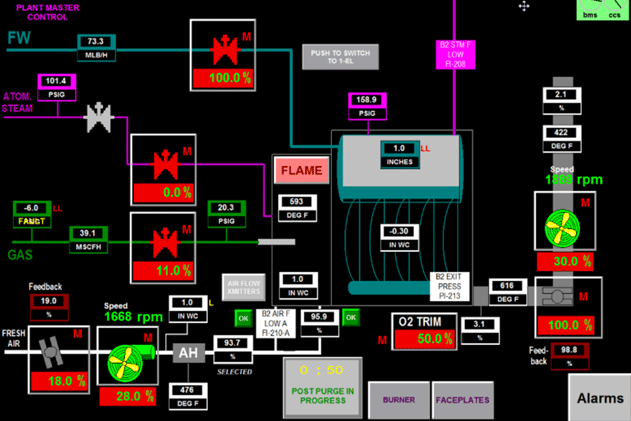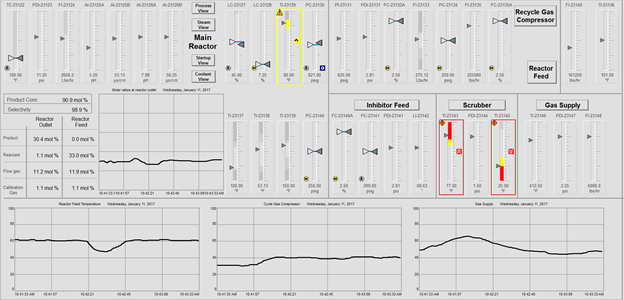Since PCs were first used to display operator interfaces on the plant floor in the early 1990s, advances in operating systems, device communication technology, and a variety of plant floor software have rapidly increased the amount of information available to operators. The theory that “more is better” was generally applied to human-machine interface (HMIs) and the trend to pack as much real-time operational information as possible onto a single screen began. The resulting interfaces were generally creative and colorful screens that mimicked the plant floor and resembled the overly designed websites on the newly emerging World Wide Web.
These late 90's, early 2000s-era graphics are still dominating the screens of many control rooms today. Of the two screens below, which graphic most closely resembles the (HMI) you spend your days looking at?


If the answer is the top graphic, do you also feel like you are frequently developing tricks to catch alarm states more quickly or creating work arounds to see key information? If so, it may be time to think about incorporating some of the concepts included in one of the latest standards from the International Society of Automation (ISA) aimed at improving operator effectiveness – ISA-101.
Getting Started with ISA-101 Concepts
While there is more to the ISA-101 standard than HMI design, there are a lot of benefits many organizations can achieve by understating the following three key concepts from this standard specifically related to HMIs:
- Situational awareness
- A four-level organizational method for HMI screens (everything your operators need to know does not need to fit onto a single screen)
- A lifecycle process to follow to develop and maintain HMIs (like many other parts of the plant floor, HMIs can benefit from continuous improvement)
To bring these concepts to your control room, it is best to start by forming a team consisting of operators, engineers, and engineering and executive management as appropriate to define the HMI design strategy. During initial discussions, it is important to emphasize how your control system should behave, not how it should look. This should involve discussions on how to contextualize information as well as how to display information so that operators know the direction a process is headed. These discussions should then lead to developing system design standards and your HMI philosophy and style guide.
While there are not any hard-and-fast rules in the ISA-101 standard regarding the exact design of a screen, some other best practices we recommend implementing to promote situational awareness in your graphics include the following:
- Using a layout of the process on the screen that is consistent with the user’s mental model of the process, including process flow from left to right.
- Creating a display that shows only what is necessary for understanding the process.
- Depicting equipment in a simple 2D manner rather than brightly colored 3D symbols with shadowing.
- Minimizing the number of crossing lines through effective object placement.
- Being cognizant of how much is included on the screen to minimize clutter.
- Including static text and objects (e.g. manual valve) only when necessary, so that it does not distract from process information. As mentioned, static information does not promote situational awareness, but we recognize that sometimes it is necessary to show static data points, such as the relative position of certain valves, on a Level 3 graphic.
- Ensuring symbols are consistent so users can quickly understand what an object represents.
- Omit animated objects including spinning motors, moving conveyors, splashing liquids, and fire-breathing burners.
Using some of these techniques to optimize your HMI can provide a low-cost method, where no new software or hardware is needed, to improve operator efficiency.
To learn more about the concepts in ISA-101 and see how you can develop a situationally aware HMI designed to inform, not distract, download our latest white paper – Improving Operational Efficiency with HMIs that Promote Situational Awareness.


